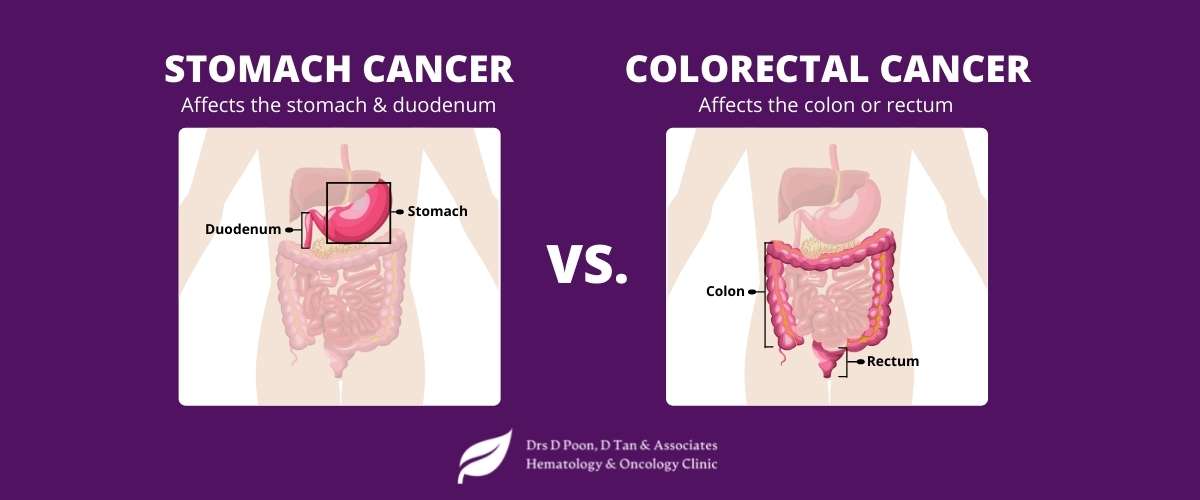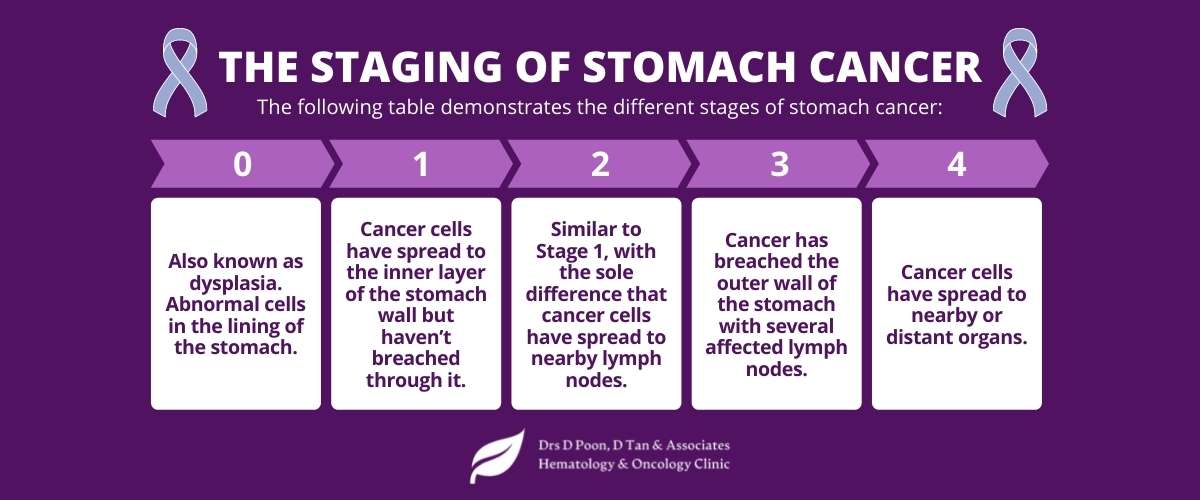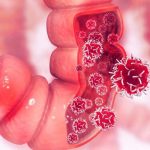
Stomach Cancer – Essentials You Need To Know
Table of Contents
- Causes of gastric cancer
- Risk factors of stomach cancer
- Stomach vs Colorectal cancer
- Symptoms of Stomach Cancer
- The staging of stomach cancer
- Diagnosis of gastric cancer
- Stomach cancer treatment
- Prevention and screening of stomach cancer
- Takeaway message
Stomach cancer, or gastric cancer, occurs when the cells lining the stomach become cancerous. Although less common than other types of gastrointestinal cancer, doctors consider stomach cancer to be relatively dangerous because patients often do not show symptoms in the early stages. This unfortunately results in late diagnosis and less effective treatment.
In Singapore, stomach cancer is the 7th and 9th most common cancer types in males and females respectively, but the 4th cause of cancer death in males and and the 5th in females. Four in every five known stomach cancer cases are detected in stage 4, when 5-year survival rate is estimated to be 5% or less.
In this article, we will cover the essentials you need to know about stomach cancer, including risk factors, causes, symptoms, treatments and preventive measures. We will also discuss screening exercises for individuals with high risk factors. Though challenging, this is critical in improving early detection and prognosis for gastric cancer patients.
Causes of gastric cancer
Like most other types of cancer, the exact triggers of stomach cancer are still unknown. All we know is that this cancer occurs when healthy cells of the upper digestive system become cancerous and multiplying uncontrollably.
The duration it takes for this cancer to develop varies but the process could last for years before any symptoms appear. This is why screening for gastric cancer is important.
Risk factors of stomach cancer
Decades of research has allowed scientists to come up with a list of risk factors for stomach cancer. Having a risk factor increases the odds of developing a disease, but not everyone with one or more risk factors is going to get it. Understanding risk factors is important because it helps guide us to take necessary precautions to manage our risk.
Stomach cancer risk factors can be categorised into 3 main groups:
Personal factors that are non-modifiable, ie., out of our control:
- Age – risk increases with age, especially after 60 years old. However, stomach cancer is observed to have hit an increasing number of younger adults in Singapore.
- Gender – males are more susceptible to gastric cancer
- Race – the Chinese ethnic group is more at risk compared to Malays and Indians, according to statistics by NRDO.
- Family history of this cancer – having a close family member with stomach cancer increases your risk for the disease.
- Genetic – a small number of stomach cancer cases are hereditary, ie., inherited, such as hereditary diffuse gastric cancer (HDGC). Other inherited genes may increase the chance of getting a few types of cancer including gastric cancer, such as Lynch syndrome, Li-Fraumeni syndrome, Peutz-Jeghers syndrome (PJS).
Lifestyle factors that are modifiable:
- Smoking
- Excessive alcohol consumption
- Unhealthy diet – such as eating too much preserved foods, processed food or charcoaled food and too little fresh fruits and vegetables
- Obesity
- Sedentary lifestyle
Medical factors that are manageable:
- Recurrent Helicobacter pylori infections
- Having adenomatous stomach polyps (adenomas)
For individuals at a high risk of gastric cancer, screening tests are indispensable to detect and control the unnoticeable growth of gastric cancer at an early stage.
Stomach vs Colorectal cancer
Anatomists divide the digestive system into two parts:
The upper digestive system – This includes the mouth, esophagus, stomach, and duodenum
The lower digestive system – This includes the jejunum, ileum, colon, rectum, and the anus
Gastric cancer affects the stomach and duodenum, whereas colorectal cancer develops in the colon or rectum.
The incidence of colorectal cancer is far more common compared to gastric cancer. Symptoms also tend to develop in the early stages, which is not the case for gastric cancer. Additionally, there are a few differences when it comes to clinical presentation, which we will cover in the Symptoms section below.
Finally, the prognosis (i.e., outcome) of both cancers is similar.

Symptoms of Stomach Cancer
Symptoms of stomach cancer typically start appearing when the tumour becomes large enough.
Some of the early symptoms include:
- Bloating after meals
- Recurrent heartburn
- Frequent burping
- Stomach pain
- Indigestion without a history of irritable bowel syndrome
- Constipation or diarrhoea without an apparent cause
- Difficulty swallowing (i.e., dysphagia)
Despite this list, diagnosing gastric cancer is challenging because there are many benign conditions that cause the same symptoms. A person may not see a GP for the above symptoms. Even if the patient seeks medical care, the doctor will need to eliminate other causes and conditions first before concluding this could be a cancer case.
In any case, it is highly recommended to seek medical care if the symptoms persist and/or worsen for a few weeks. And now that we know about risk factors, be sure to discuss with the doctor about your risks and the appropriate screening or testing measures.
Once the tumour becomes large enough, the following symptoms may arise:
- Loss of appetite
- Unexplained weight loss
- A buildup of fluids in the stomach (it may feel lumpy)
- Vomiting, including vomiting blood
- Anaemia and fatigue due to blood loss
- Melena (i.e., black stools because of blood)
Compared to colorectal cancer, the primary differences in symptoms revolve around stool colour and pain location.
Gastric cancer always presents with black stools – this is because the blood gets oxidised during its trip from the stomach to the rectum. On the other hand, colorectal cancer can present with melena (black stool) but also with bright red blood.
As for pain location, gastric cancer causes pain in the upper digestive system, whereas colorectal cancer pain is more likely to occur in the lower part of the abdomen. We have a separate guide to colorectal cancer in our blog.
The staging of stomach cancer
Staging for most types of stomach cancer is based on the TNM (Tumour, Node, Metastasis) system. A case is staged based on findings of where the cancer cells have grown to, whether cancer has spread to the lymph nodes, and to which organs it has metastasised. The following table summarises the main stages of stomach cancer. In clinical practice, you might also hear further classification, such as Stage 1B or 2A.

Stage 0: Abnormal cells are round in the lining of the stomach. This stage is also known as dysplasia
Stage 1: Cancer cells have spread to the inner layer of the stomach wall but haven’t breached through it.
Stage 2: Similar to Stage 1, with the sole difference that cancer cells have spread to nearby lymph nodes
Stage 3: Cancer has breached the outer wall of the stomach with several affected lymph nodes.
Stage 4: Cancer cells have spread to nearby or distant organs.
Diagnosis of gastric cancer
Your doctor will take your history by enquiring details about any symptoms you have, your family history, and your lifestyle habits. Next is the physical examination, during which the doctor checks for any tenderness or lumpiness in the gastric region. Blood tests may be helpful as well. These include a complete blood count (CBC), inflammatory markers, and cultures.
As we mentioned above, the diagnosis of stomach cancer is challenging, due to the lack of specific symptoms in gastric cancer. If you are seeing a family doctor or general practitioner, he/she will refer you to a specialist in gastroenterology or an oncologist once the diagnosis of gastric cancer is probable.
Upon seeing the specialist or oncologist, you may expect the following procedures to be ordered:
- CT scan: This imaging technique produces clear images of your stomach to identify any unusual growths. The characteristics of the tumour allow your doctor to suspect stomach cancer.
- Barium swallow: During this test, you will swallow a liquid that contains barium. This will make your upper digestive tract light up on a standard X-ray.
- Gastroscopy: Also known as upper endoscopy, a procedure that helps the doctor look inside your stomach.
The role of gastroscopy in diagnosis of gastric cancer
During a gastroscopy, the doctor inserts a long tube with a high-quality camera and a source of light into your mouth to reach the stomach and duodenum (the last portion of the upper digestive tract). The device is called the gastroscope. The procedure can be conducted under local or general anaesthesia.
If any unusual growth is seen during gastroscopy, your doctor will use the tip of the endoscope to take a tissue sample (i.e., biopsy), or in certain cases, to remove the polyps altogether. The next step would be to send the collected sample to a pathologist who will identify histological features of gastric cancer. It is important to note that biopsy is the only definitive test to firmly diagnose gastric cancer.
Stomach cancer treatment
Depending on the staging of gastric cancer, treatment varies greatly. This section provides an overview of the available general therapies for stomach cancer, which include:
- Surgery
- Chemotherapy
- Radiation therapy
- Targeted treatments
Surgery
Surgery aims to remove the tumour and some of the healthy tissues that surround it with the purpose of reducing the risk of relapses.
Depending on the staging of cancer, the surgeon may choose one of these techniques:
Endoscopic mucosal resection – Using gastroscopy, the surgeon will remove tiny tumours from the surface of your stomach. This is only useful for the early stages of gastric cancer.
Subtotal gastrectomy – Removal of a section of the stomach through surgery. This is recommended when cancer has spread locally.
Total gastrectomy – Removal of the whole stomach. This procedure is reserved for advanced cases.
Radiation therapy
Radiation therapy is not very common in stomach cancer protocols. This is because of the high risk of damaging nearby organs. In advanced cases of gastric cancer, radiation therapy can be a viable option, especially when the cancer is causing severe symptoms (e.g., intense pain, excessive bleeding).
This treatment is rarely conducted alone, however. Oncologists typically use radiation therapy in combination with chemotherapy. The combination can help reduce the size of the tumour before surgery. This is known as neoadjuvant treatment
Chemotherapy
Chemotherapy contains drugs that kill rapidly-growing cells, which is a feature of all cancer cells. Doctors refer to these medications as cytotoxic drugs. While these drugs help with shrinking the cancer, they also cause many side effects to healthy cells with a rapidly-growing nature such as intestinal cells or skin cells.
Targeted therapy
Targeted medications focus on specific proteins that only cancer cells produce. They have become more popular in recent years compared to chemotherapy thanks to their advantage of reducing the toll of side effects. However, a patient must often meet certain criteria to be a candidate for targeted therapy. For instance, a tumour profiling test needs to show that a specific molecular target is present.
Examples of these targeted medications include:
Trastuzumab (Herceptin) – This drug targets HER2, which is a protein that promotes cell growth. Patients are eligible for this medication if their genetic testings are positive for HER2 genes.
Ramucirumab (Cyramza) – this drug blocks the process of developing new blood vessels for the tumour.
Prevention and screening of stomach cancer
Unfortunately, there is no sure way to prevent stomach cancer altogether. The next best thing we can do to protect ourselves is to make changes in our daily lifestyle to control and reduce our risk. These may include:
- Eating a healthy diet
- Exercising on a regular basis
- Keeping a healthy weight
- Quitting smoking
- Avoiding too much alcohol
If you have some conditions that increase the risk of gastric cancer, treating them can prove life-changing. For instance, chronic infection with H. pylori is a well-identified risk factor for this cancer. Getting appropriate treatment such as triple therapy to eradicate the bacteria from your stomach will lower your risk of stomach cancer.
Stomach cancer is highly treatable if detected early. As it does not display noticeable symptoms in the early stages, screening tests are also a viable option for individuals with a high risk of stomach cancer. Consulting a doctor or an oncologist for a screening strategy and following through with it is important for early detection, as well as for your peace of mind. Depending on your risk profile, screening may involve the following:
- A comprehensive physical examination
- Laboratory tests (complete blood count test)
- Gastroscopy
- CT scan and X-rays
- Genetic testing: A blood test called GASTROClearTM is the world’s first molecular blood test approved for use in Singapore for early detection of gastric. Do consult the oncologist to learn more.
Takeaway message
Despite being relatively less common, many cases of stomach cancer have a poor outcome, due to late diagnosis. We hope that this article provides a useful overview of important aspects of stomach cancer, and how we can work to reduce its incidence. By far, knowing your risk profile, taking preventive measures and going for screening tests remain the best way to proactively combat this cancer.
Dr Donald Poon




